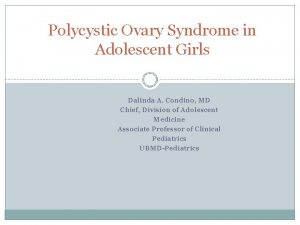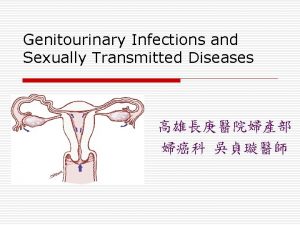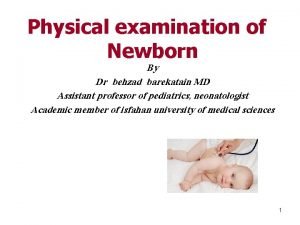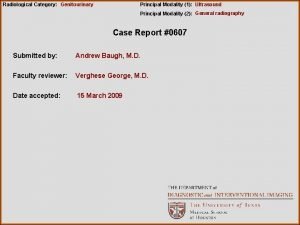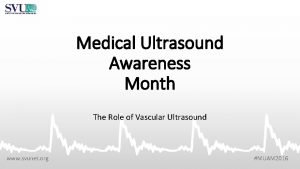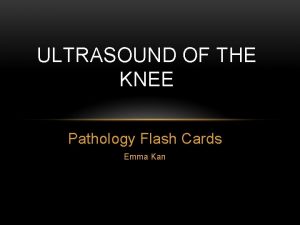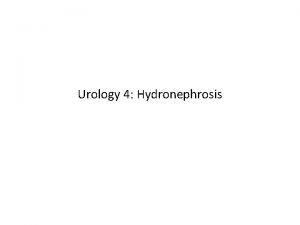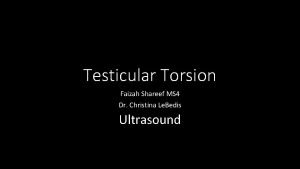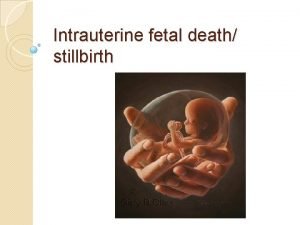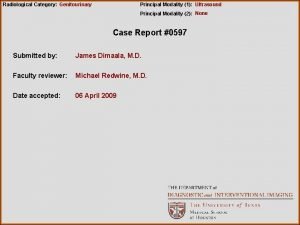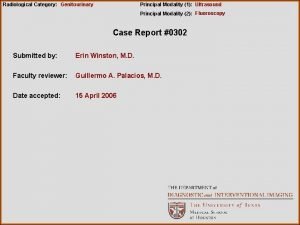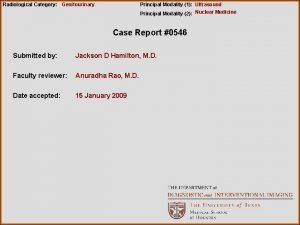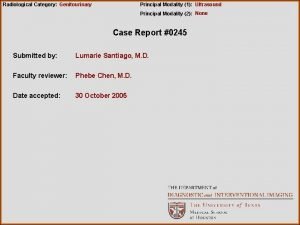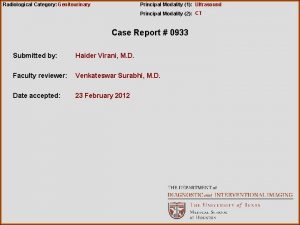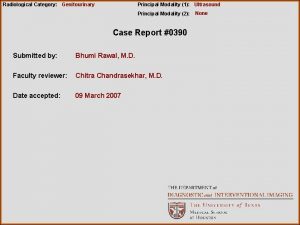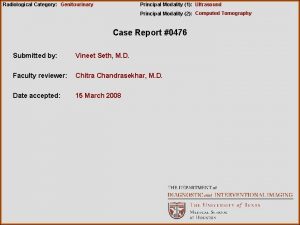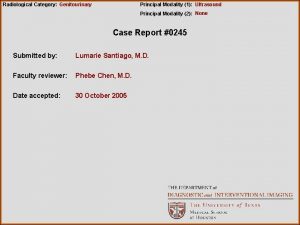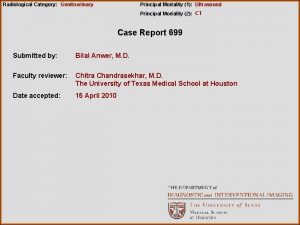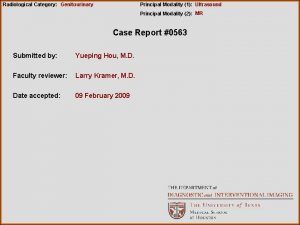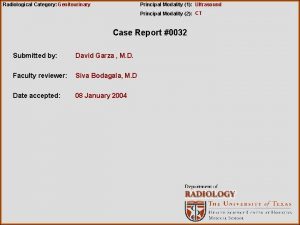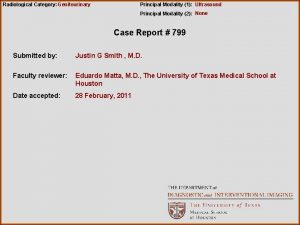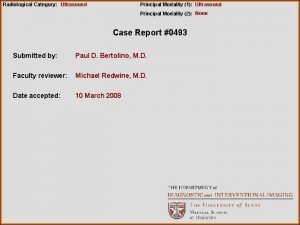Radiological Category Genitourinary Principal Modality 1 Ultrasound Principal









































- Slides: 41

Radiological Category: Genitourinary Principal Modality (1): Ultrasound Principal Modality (2): CT Case Report #0291 Submitted by: Jennifer C. Lin, M. D. Faculty reviewer: Chitra Chandrasekhar, M. D. Date accepted: 15 April 2006

Case History 21 year-old HM with no past medical history presents with a left-sided neck mass.

Pathological Findings Ultrasound with grey scale imaging and color doppler

Pathological Findings Axial contrast enhanced CT

Pathological Findings Axial contrast enhanced CT

Pathological Findings Axial contrast enhanced CT

Pathological Findings Axial contrast enhanced CT

Pathological Findings Axial contrast enhanced CT

Pathological Findings Axial contrast enhanced CT

Pathological Findings Axial contrast enhanced CT

Pathological Findings Axial contrast enhanced CT

Pathological Findings Axial contrast enhanced CT

Pathological Findings Axial contrast enhanced CT

Pathological Findings Axial contrast enhanced CT

Pathological Findings Axial contrast enhanced CT

Pathological Findings Axial contrast enhanced CT

Pathological Findings Axial contrast enhanced CT

Pathological Findings Axial contrast enhanced CT

Pathological Findings Axial contrast enhanced CT

Pathological Findings Axial contrast enhanced CT

Pathological Findings Axial contrast enhanced CT

Pathological Findings Axial contrast enhanced CT

Findings and Differentials: • Lymphadenopathy • Lymphoma • Lymphoproliferative disease • Sinus neoplasm • Salivary gland neoplasm • Rhabdomyosarcoma • Dacrocystocele • Lymphoepithelial cysts • Infectious process • Metastatic disease

Findings and Differentials Findings: The initial neck ultrasound shows a heterogeneous multilobulated hypoechoic left sided neck mass measuring 2. 9 x 5. 1 x 2. 0 cm. Internal cystic components with septations and areas of increased echogenicity are noted.

Findings and Differentials Findings: With color doppler, longitudinal view shows a slightly hypervascular lesion.

Findings and Differentials Findings: On CT, a heterogeneous soft tissue mass is noted to involve the left parotid gland, paranasal sinuses and medial orbital canthus region.

Findings and Differentials Findings: Extensive lymphadenopathy of the left neck is seen.

Findings and Differentials Findings: Soft tissue also extends to the left ethmoid and frontal sinuses. There was no bony involvement.

Discussion This patient presents with a soft tissue mass extending from the left parotid gland to the left medial canthus area in addition to extensive left neck lymphadenopathy. The differential diagnosis for lymphadenopathy of the neck in a nonimmunocompromised patient includes lymphoproliferative disease, infection (TB, cat scratch disease, Brucellosis), and lymphoma. The differential diagnosis for a parotid soft tissue mass includes a primary neoplasm (mucoepidermoid carcinoma, adenoid cystic carcinoma), or lymphoma. Furthermore, the differential diagnosis for a soft tissue mass in the medial canthus region includes a dacrocystocele, a primary neoplasm, lymphoproliferative disease, and lymphoma. In immunocompromised patients, lymphoepithelial cysts may be included in the differential. Metastatic disease to the paranasal sinuses or salivary glands is extremely rare. This patient has no prior history of a primary neoplasm. Bone scan was negative.

Radiological Presentations The patient underwent a neck biopsy. Histological examination revealed an alveolar rhabdomyosarcoma.

Case History Three months later, the patient returned complaining of painless bilateral testicular masses.

Radiological Presentations Ultrasound with grey scale imaging

Radiological Presentations Color doppler ultrasound

Test Your Diagnosis Which one of the following is your choice for the appropriate diagnosis? After your selection, go to next page. • Primary testicular carcinoma • Metastatic disease • Lymphoma • Rhabdomyosarcoma

Findings and Differentials Findings: Scrotal ultrasound with color doppler showed multiple bilateral heterogeneous hypoechoic testicular masses with increased vascularity. Several calcifications are present.

Findings and Differentials: • Orchitis • Seminoma • Nonseminoma: • Mixed Germ Cell Tumor • Teratoma • Teratocarcinoma • Embryonal cell carcinoma • Choriocarcinoma • Leydig cell tumor • Sertoli cell tumor • Yolk sac tumor • Rhabdomyosarcoma • Lymphoma • Leukemia • Melanoma

Discussion Orchitis is usually associated with epididymitis, and is painful. This patient presents with bilateral painless masses. However, focal enlargement of the testicle, decreased echogenicity, and increased vascularity may all represent orchitis. A palpable intratesticular mass is likely to be malignant. The most common neoplasms are seminomas and mixed germ cell tumors. On ultrasound, seminomas are usually homogeneous and hypoechoic. Calcifications and cystic changes are rare in seminomas. Mixed germ cell tumors are usually heterogeneous and may have calcifications and cystic changes. Leydig and Sertoli cell tumors are solid masses with variable echogenicity. Metastatic disease is more common in elderly patients, and also has variable echogenicity. Leukemia and lymphoma may also occur in the testes, especially since chemotherapy does not cross the blood-testis barrier. They can appear as focal hypoechoic masses or as diffuse testicular infiltration. If the testis is completely infiltrated, color doppler will reveal an overall incresed vascularity. Leukemia, lymphoma and melanoma are the most common metastatic lesions to the testes.

Pathological Findings The patient then underwent a right orchiectomy.

Pathological Findings Histological examination of the testicular masses revealed alveolar type rhabdomyosarcoma consistent with the primary rhabdomyosarcoma of the neck. This was confirmed with a desmin stain for muscle.

Discussion Rhabdomyosarcoma is a rare cause of intratesticular masses. It is a neoplasm derived from skeletal muscle. Over 85% of rhabdomyosarcomas occur in infants, children, and teenagers. The most common sites are the head and neck (30 -40%) and the genitourinary tract (20 -25%). Less commonly, they occur in the extremities (18 -20%) and the trunk (7%). There are two types of rhabdomyosarcoma: embryonal rhabdomyosarcoma (ERMS) and alveolar rhabdomyosarcoma (ARMS). ERMS usually occurs in infants and children and is commonly found in the head and neck or genitourinary tract. ARMS usually occurs in teenagers and is commonly found in the extremities or trunk. Our patient is unusual in many respects. Histology revealed ARMS in both the neck and testicular masses, though ERMS is usually more common in these locations. Furthermore, it is very unusual to see isolated metastases to the bilateral testes from the neck without the involvement of any other organs. CT of the chest, abdomen and pelvis was negative. Lastly, our patient is older than the typical age range for rhabdomyosarcoma.

Diagnosis Bilateral testicular metastases from alveolar rhabdomyosarcoma of the neck. References: Cotran, R. S. , Kumar, V, Collins, T. Robbins Pathologic Basis of Disease. 6 th Edition: 1999. Philadelphia, W. B. Saunders Company; p. 1265 -1266. Grossman, R. I. et al. Neuroradiology: the Requisites. 2 nd Edition: 2003. Philadephia, Mosby; p. 635 -638, 709 -712. Holliday, R. A. , Cohen, W. A. et al. Benign Lymphoepithelial Parotid Cysts and Hyperplastic Cervical Adenopathy in AIDS-risk patients: a new CT appearance. Radiology 1988; Vol 168, 439 -441. Howlett, D. C. High Resolution Ultrasound Assessment of the Parotid Gland. British Journal of Radiology 2003; 76: 271 -277. Middleton, W. D. et al. Ultrasound: the Requisites. 2 nd Edition: 2004. St. Louis, Mosby; p. 160 -164, 257 -259.
 Pcos ultrasound vs normal ultrasound
Pcos ultrasound vs normal ultrasound Aerohive erate
Aerohive erate Radiological dispersal device
Radiological dispersal device Tennessee division of radiological health
Tennessee division of radiological health Center for devices and radiological health
Center for devices and radiological health National radiological emergency preparedness conference
National radiological emergency preparedness conference Genitourinary & stds
Genitourinary & stds Male genitourinary anatomy
Male genitourinary anatomy Chapter 29 the child with a genitourinary condition
Chapter 29 the child with a genitourinary condition Nursing care of male patients with genitourinary disorders
Nursing care of male patients with genitourinary disorders Chapter 29 the child with a genitourinary condition
Chapter 29 the child with a genitourinary condition Deontic modality
Deontic modality One to many relationship line
One to many relationship line Modality stats
Modality stats Modality erd
Modality erd Sodality vs modality
Sodality vs modality Entity class in software engineering
Entity class in software engineering Epistemic modality
Epistemic modality Birads
Birads Cardinality and modality in database
Cardinality and modality in database Past tense in xhosa
Past tense in xhosa Modality in software engineering
Modality in software engineering Deontic and epistemic modality exercises
Deontic and epistemic modality exercises Modality in software engineering
Modality in software engineering Exteroceptors
Exteroceptors Lexical vs auxiliary verbs
Lexical vs auxiliary verbs Skill focus: persuasion
Skill focus: persuasion Cardinality and modality
Cardinality and modality Pacs modality workstation
Pacs modality workstation Diplode
Diplode Callendreasonlocaluserinitiated
Callendreasonlocaluserinitiated Pinna below outer canthus of eye
Pinna below outer canthus of eye Causes of decreased fetal movement
Causes of decreased fetal movement Hypoechoic ultrasound
Hypoechoic ultrasound Ultrasound awareness month
Ultrasound awareness month Synovial thickening
Synovial thickening Fetal hydronephrosis ultrasound grading
Fetal hydronephrosis ultrasound grading Christina shareef
Christina shareef Icp monitoring
Icp monitoring Ekos ultrasound
Ekos ultrasound Spalding sign ultrasound
Spalding sign ultrasound Cbd ultrasound
Cbd ultrasound
